#supersonic transport
Text

A former TWA Boeing 2707 SST in the boneyard.
Note: happy April fool's day
Date: April 1, 1998
source
#Boeing 2707-300#Boeing 2707#2707-300#2707#Supersonic Transport#SST#Supersonic Transport Project#National Supersonic Transport Program#NST#Supersonic Passenger Airliner#Cancelled#boneyard#TWA#1998#april fool's day#april fool's#April#my post
42 notes
·
View notes
Text

Concorde taking off from Orly Int'l Airport, Paris
#Concorde#SST#Supersonic Transport#airliner#passenger jet#Supersonic airliner#commercial aviation#Jet photos#aviation#Concorde take off#planes
42 notes
·
View notes
Text

A conceptual rendering of a supersonic transport flying over the then new Dallas Fort Worth International Airport.
#vintage illustration#vintage aircraft#aircraft#commercial aircraft#civilian aircraft#airplanes#vintage airplanes#passenger planes#airlines#airliners#jet airliners#sst#commercial jets#supersonic transport#dfw airport#dallas fort worth international airport
9 notes
·
View notes
Text
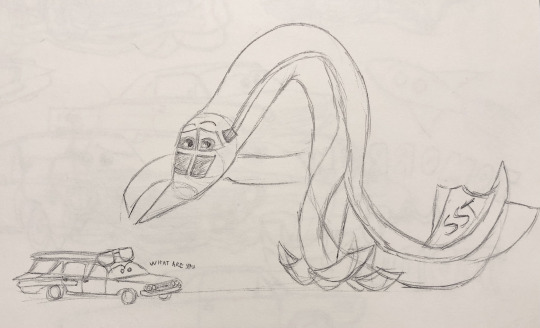
When two of your characters from different ‘verses meet...
#pixar cars#cars fandom#living machines#planes#aviation#supersonic transport#boeing 2707#station wagon#Thomas Brookwood#Snakeplane#my art#art
4 notes
·
View notes
Text
what's new with super-sonic flight
NASA and Lockheed Martin claim to have a prototype supersonic jet whose sonic boom sounds “like a car door slamming heard from inside”. This could open the door to commercial supersonic flight over populated areas. Well, we don’t even have commercial super-sonic flight over the oceans at the moment, which would be helpful to long-haul travelers. The article doesn’t say when this might happen, but…
View On WordPress
0 notes
Photo
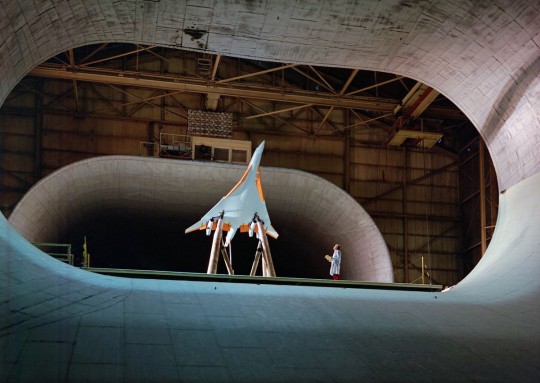
A wind-tunnel model of a supersonic transport undergoing testing at NASA Langley Research Center on January 17, 1975
268 notes
·
View notes
Text
Supersons +1 prompt answer Parte Dos
Parte Uno
Original Prompt
Jon couldn't help but take a peek at the large metal ring constructed behind the massive form of Dr Fenton, its size and shape dwarfing man and son. He couldn't watch for much longer, however, as their encounter with Daniel was expedited by Damian's impatience. Maybe he was just itching for a fight, or a supervillain to beat down. Either way, as Superboy, it was his job to make sure Daniel walked out with all his limbs intact!
"Daniel Fenton." But Damian was interrupted just as fast as he had started.
"Ew, no, it's Danny thank you very much. Only my parents when they're angry, and- bleh- Vlad, call me Daniel."
Damian scowled (he was doing that a lot today). "Daniel Fenton, we have some questions for you."
"Guess that's not gonna happen."
Time to intervene. Jon stepped between Damian and Danny, arms outstretched, with a friendly but diplomatic smile. "What Damian here means is we're suuuuper curious about your dad's research, aren't you Damian?"
"...Yes."
"If you wanna know more about my Dad's research, why don't you uhh." Danny bobbed his head at Mr Fenton's direction, the man in the midst of grabbing onto an unfortunate bystander and extolling the virtues of his next invention.
"Your father has proven lacking in his ability to explain his own work, which is why the responsibility now falls on to you, Daniel Fenton, if that's even your real name."
Wow, laying it on real thick, aren't you Damian.
Danny very pointedly ignores the death stare (hehe, death stare) from Dami to look to Jon. "And you are...?"
"Jon, I'm here with my dad too! He's a reporter, but some of this stuff's got me bored out of my mind. I mean, a flying toilet? Really??"
This manages to get a chuckle out of Danny. "You saw that too? And here I thought I'd get to see some normal inventions around here."
"I know right! I feel subconscious even with bathroom stalls and stuff. What are you gonna do, bring a flying curtain?"
"Honestly I know some folks back home who could find it handy." Danny said, a mysterious smirk on his lip. What could be so mysterious about a bunch of streakers back home? Or...
"Would you like to elaborate on that statement, Fenton?" Damian cut in. "Or the function of the garish-looking gateway erected by your Father?"
"Oh that? That's the Fenton PortaPortal."
"Porta what?" Jon asked.
"The Porta Portal. Portable Portal. It's like the one back home, 'cept it's light enough to move around."
"Portal to where exactly?"
Danny shrugs. "The Ghost Zone, where else?"
"You mean to say your parents have breached the afterlife using science?"
"Hah!" Danny laughs. "But it won't work, trust me." There was that knowing grin again.
"You seem pretty sure, Danny. Also wait, you have one of these back home?"
"Yeah, and it let in the raging hordes of the undead on my town. Overshadowing (that's possession btw), taking over the school with meat, box-based assault, replacing people like changelings, that one time a ghost tried to blow up my sister with a laser, that one time the Ghost King kidnapped the entire town and transported it to the Realms..." Danny listed out various dangerous situations like it was Tuesday, ignorant of the dawning horror upon his audience's faces. Jon himself was starting to feel a little green. Ghosts? Hundreds of ghosts? Each of them capable of possession, and according to Danny, much more?!
"How has the Justice League not heard of this kind of thing?" Jon tried, but failed to hide the slight shiver in his voice.
Danny shrugged. "Guess they dismissed our calls as pranks or something."
"Your father wishes to unleash the legions of undead upon Gotham?!" Damian stepped forward, getting up in Danny's face.
"Woah woah woah, chill out man. Mom and Dad actually learned from the last time and built like eight layers of shielding around the portal, not that it'll be necessary since it won't work anyway."
"And why are you so sure? Did you sabotage it? For whwat purpose would you tamper with your own parents' inventions?"
"Dami, maybe we shouldn't jump to conclusions." Jon said, trying to pull Damian away without any obvious use of super strength.
"Yeah Dami, I'm just a kid, like you. You see an engineering degree anywhere that can be used to sAboTAgE anything? 'Cause I don't."
Damian glared at the other boy for just a second longer, before Jon was finally able to pry him off the poor kid. "I'm so sorry, Damian's just kinda intense sometimes, he really means well I-"
"It's fine. Besides, I'm bored as hell over here too. Since we're about sixty-nine million years below the average age of this place. what say we hang and laugh?" Danny got up and stretched his legs.
"Sure! Hey you seen the oven that's supposed to bake pizza in under ten seconds? Come on, Damian spotted this amazing design flaw, you just have to come with."
As Jon dragged them away, Damian muttered under his breath, deviously. "Good job, Kent, escorting Fenton to a secondary location for further questioning."
~~~~~
They spent the next hour roaming the convention centre, laughing and snorting their lungs out at the inventions, and the rich suckers lapping them up. Although Damian was initially as frosty as Superman's ice breath, Danny's mention of a glowing green ghost dog managed to gain his attention, if veiled behind suspicion and accusation. Looks like no squeezing was necessary, but the idea of a whole town of magical beings that possessed as easily as they breathed still made Jon nauseous.
"My parents actually get me keep him, without the threat of dissection, it's amazing!"
"Your parents dissect animals?" Damian spat out with all the hatred of a thousand dying suns.
"Ghosts, and they never have. Kept getting away. For some reason. Nowadays they're more into non-invasive study. and by non-invasive I mean totally invasive of things like privacy, and alone time." Danny grumbled.
"I feel you, man." Imagine having a dad with super hearing. Or growing up with the world's greatest stalkers.
"Privacy is an illusion." Damian being normal challenge IMPOSSIBLE
They had no more time to banter before Dr Fenton's booming voice echoed across the centre.
"AND NOW FOR THE MOMENT YOU'VE ALL BEEN WAITING FOR, THE SHOWCASE OF THE FENTON PORTAPORTAL AND THE LATEST IN FENTON SURVEILLANCE TECHNOLOGY, BEHOLD!"
"Just watch." Danny said.
Jack slammed his fist upon the on button, which was thankfully on the outside this time. The circular rings around the portal spun and spun, creating an electric whirring sound building up to a crescendo...
Only for the portal to fizzle out, as the crowd's jeers reached a fever pitch.
"Told you so."
Danny's triumph lasted not for another minute, however, when his body shivered and a cold mist broke through his lips. "Shit." He muttered. At least Jon and Damian were looking away. Danny's eyes scanned the crowd. Jack Fenton's sorrow was wiped away as the sensors in his suit came to life. He whipped out a comically large ecto-gun, shouting. "I KNEW IT! WE'RE UNDER ATTACK FROM GHOSTS!!!"
Danny needed look no longer as piercing laughter filled the auditorium. A swarm of green bats descended upon the centre, causing chaos and confusion. Those among the crowd sensible enough to run for the exits found themselves halted by bars locking them shut. Jack opened fire, but was overwhelmed by dozens of ghost bats.
Danny looked for anywhere he could silp away and transform. Damian and Jon did the same. None of them could an opportunity, as two pairs of hands swept them off their feet, and bindings tied them together. Their eyes widened as they gazed upon their captors. Two men adorned with white face paint. One in a gothic waistcoat, the other with green hair and a purple suit.
The infamous Joker, and the not as infamous Freakshow, both in hysterical laughter.
"I really gotta give it to you Danny-boy, that sabotage act you pulled really put us for a loop!" The Joker gasped out between laughs. He pulled out a remote with a large red button. "But I, the Joker, have out-sabotaged your sabotage! AHAHAHAH"
The Joker pressed the buttom, causing the portal to roar back to life.
"Damian!" Bruce Wayne yelled.
"Jon!" Clark Kent shouted.
"DANNY BOY!" Jack cried out, but they were too late to stop the swarm of bats carrying all three boys through the newly reactivated portal, and were too late to follow before the whole thing blew to pieces in a fiery halo.
To be continued....
#dpxdc#dcxdp#danny phantom x dc#danny phantom#danny fenton#crack#prompt answer#jon kent#jack fenton#damian wayne#shenanigans#supersons#ghost zone#infinite realms#good parents jack and maddie#we need more good parents content where they still try to shoot danny#it needs to happen#i am an amateur writer plz forgive me#I am a stoopid so sowwy for any OOC ;-;
227 notes
·
View notes
Text
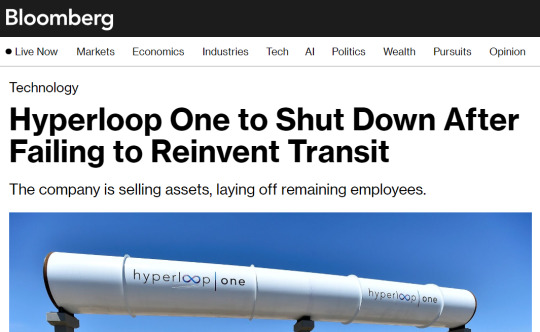
Hyperloop One, the futuristic transportation company building tube-encased lines to zip passengers and freight from city to city at airplane-like speeds, is shutting down, according to people familiar with the situation.
Once a high-profile startup, Hyperloop One raised more than $450 million since its founding in 2014, according to PitchBook. It built a small test track near Las Vegas to develop its transportation technology, and for a time took the name Virgin Hyperloop One after Richard Branson’s Virgin invested. Virgin removed its branding after the startup decided last year to focus on cargo rather than people.
Buried halfway through: it's another failed Elon Musk venture.
Not mentioned at all: the only reason Musk proposed Hyperloop was to thwart California's high-speed rail initiative and sell more cars. You see, his alternative technology of shooting supersonic capsules through evacuated vacuum tubes would be so much better than stinky old trains.
The only problem?
None of the technology exists. All the prototypes sucked. Even after ten years and a half billion dollars.
One "prototype" is literally a one-lane concrete tunnel allowing a single Tesla automobile to travel at astonishing speeds up to 107 MPH. Technically you can drive faster than that on most american highways.
Also that's 50-100 MPH slower than the high speed rail California wanted to implement a decade ago.
And now the whole venture is quietly going away.
Unpaywalled version here.
291 notes
·
View notes
Text

woe, supersonic transport yuri be upon ye
164 notes
·
View notes
Text
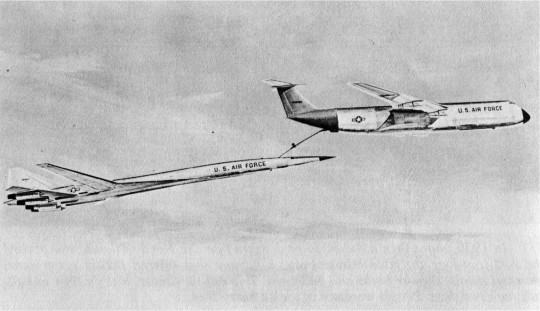
"The SST: Here it comes, ready or not.
Traditionally new transport aircraft have been adapted from military versions for civilian use. But with the US/SST, a switch may give the USAF an Advanced Manned Strategic Aircraft (AMSA) based on a civilian expenditure of billions in research and development funds. Here, Air Force & Space Digest artist Gordon Phillips shows how military SST would look during midair re-fueling operation.
by Don Dwiggins, Doubleday & Company, Inc., 1968"
Artwork by Gordon Phillips
Posted on Flickr by Numbers Station: link
#Boeing 2707-100#Boeing 2707#2707-100#2707#Supersonic Transport#SST#Supersonic Passenger Airliner#Cancelled#Lockheed C-5 Galaxy#C-5#Cargo Plane#United States Air Force#U.S. Air Force#US Air Force#USAF#inflight refueling#1960s#my post
26 notes
·
View notes
Text
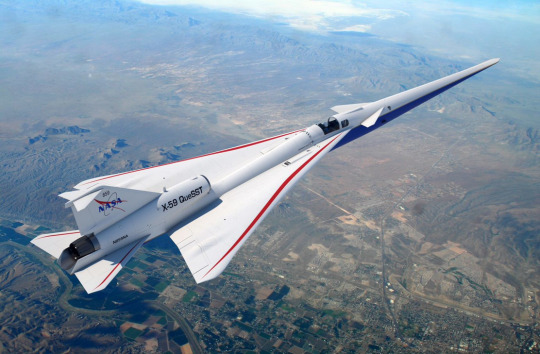
Lockheed Martin X-59 "QuessT"
The Lockheed Martin X-59 Quiet Supersonic Transport (QuessT) experimental supersonic aircraft being developed at Skunk Works for NASA's Low-Boom Flight Demonstrator project. Preliminary design started in February 2016, with the X-59 to be delivered to NASA in 2021 for flight testing in 2023.
128 notes
·
View notes
Photo

A new world of flight will begin in 1969. And Pan Am will begin it.
#vintage advertising#vintage travel#pan am#pan american airlines#1969#the 60s#sst#supersonic transport#boeing 747
13 notes
·
View notes
Text
Annie Stegg Gerard's "The Garden Beyond."









Currently on view at Haven Gallery in Northport, New York is artist Annie Stegg Gerard's solo exhibition, "The Garden Beyond."
“The Garden Beyond” is a collection of oil paintings depicting mythological beings in lush, verdant forests as they peacefully cohabit the landscape with woodland creatures. Sprites, fae, naiads, dryads, sylphs, fairies and other fabled beings peacefully intermingle with animals, insects, flora and fauna, providing the viewer a glimpse into the worlds existing inside the trees, under the flowerbeds and in the recesses of the shrubs.
Arcadian landscapes teeming with Pre-Raphaelite influence are evoked through Stegg Gerard’s imaginative oeuvre of fairy-tale motifs and narratives, transporting viewers into worlds familiar, yet magical. Vast places we have not visited since our childhood, filled with wonder, story, harmony and companionship amidst all living beings.

THE SUPERSONIC ART SHOP | FOLLOW ON INSTAGRAM
263 notes
·
View notes
Text
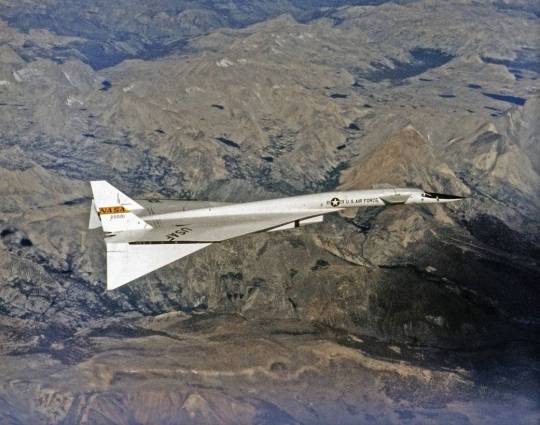
XB-70 Valkyrie
XB-70 Valkyrie in Cruise Configuration
The No. 1 XB-70A (62-0001) is viewed from above in cruise configuration with the wing tips drooped for improved controllability.
The XB-70 Valkyrie, with a planned cruise speed of Mach 3 and operating altitude of 70,000 feet, was to be the ultimate high-altitude, high-speed manned strategic bomber. Events, however, would cause it to play a far different role in the history of aviation.
To achieve Mach 3 performance, the XB-70 was designed to “ride” its own shock wave, much as a surfer rides an ocean wave. The resulting shape used a delta wing on a slab-sided fuselage that contained the six jet engines that powered the aircraft. The outer wing panels were hinged. During take off, landing, and subsonic flight, they remained in the horizontal position. This feature increased the amount of lift produced, improving the lift-to-drag ratio. Once the aircraft was supersonic, the wing panels would be hinged downward. Changing the position of the wing panels reduced the drag caused by the wingtips interacted with the inlet shock wave. The repositioned wingtips also reduced the area behind the airplane’s center of gravity, which reduced trim drag. The downturned outer panels also provided more vertical surface to improve directional stability at high Mach numbers. Attached to the delta was a long, thin forward fuselage. Behind the cockpit were two large canards, which acted as control surfaces.
XB-70: World's Largest Experimental Aircraft in the 1960s.
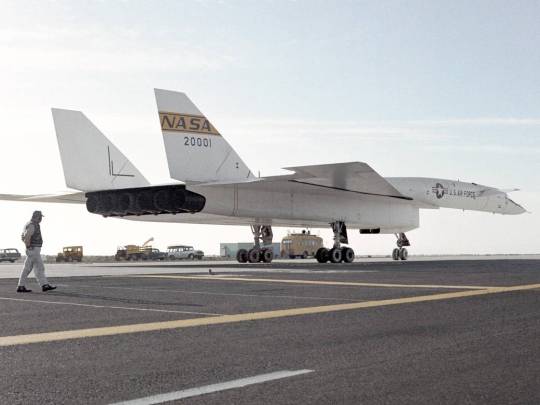
The figure standing on the ramp provides a size comparison with the XB-70A aircraft.
As impressive a technological feat as the XB-70 represented, the aircraft was under development at a time when the future of the manned bomber was uncertain. During the late 1950s and early 1960s, many believed that manned aircraft were obsolete, and the future belonged to missiles. As a result, the Kennedy Administration ended plans to deploy the B-70. Two experimental XB-70A prototypes were under construction at North American Aviation when the program was canceled.
At the same time there was growing interest in an American supersonic transport (SST). Jet airliners had cut flight times by more than half in comparison to propeller-powered aircraft. A Mach 2 or 3 SST would make a similar improvement over the new subsonic jet airliners. The Flight Research Center (FRC-now the Armstrong Flight Research Center, Edwards, CA.) had several SST studies underway during the early 1960s. NASA’s Douglas F5D-1 was used for landing studies, a North American F-100C was modified to simulate SST handling qualities, a North American A-5A was used to simulate an SST for tests of the air traffic control system, and a Lockheed JetStar was modified as an in-flight SST simulator.
On the Ramp: XB-70
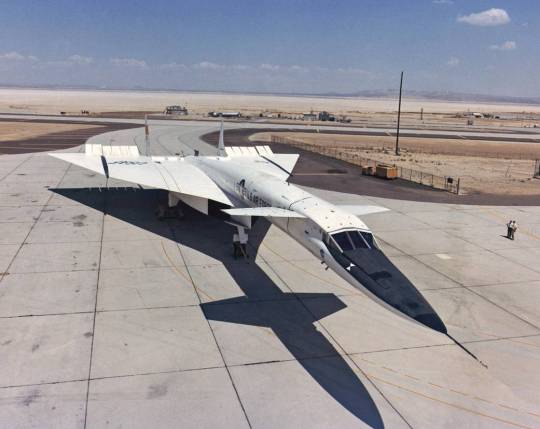
The XB-70A is shown parked on a ramp at Edwards, California, in 1967.
The XB-70 Valkyrie seemed to be a perfect testbed for SST research. It was the same size as the projected SST designs, and used similar structural materials, such as brazed stainless steel honeycomb and titanium. Thus, the XB-70A’s role changed from a manned bomber prototype to one of the most remarkable research aircraft ever flown.
The XB-70A number 1 (62-001) made its first flight from Palmdale to Edwards Air Force Base, CA, on Sept. 21, 1964. Tests of the XB-70’s airworthiness occurred throughout 1964 and 1965 by North American and Air Force test pilots. The Flight Research Center prepared its instrument package. Although intended to cruise at Mach 3, the first XB-70 was found to have poor directional stability above Mach 2.5, and only made a single flight above Mach 3. Despite the problems, the early flights provided data on a number of issues facing SST designers. These included aircraft noise, operational problems, control system design, comparison of wind tunnel predictions with actual flight data, and high-altitude, clear-air turbulence.
NASA Ames Research Center, Moffett Field, CA, wind-tunnel studies led engineers at North American Aviation in Downey, CA, to build the second XB-70A (62-207) with an added 5 degrees of dihedral on the wings. This aircraft made its first flight on July 17, 1965. The changes resulted in much better handling, and the second XB-70 achieved Mach 3 for the first time on Jan. 3, 1966. The aircraft made a total of nine Mach 3 flights by June.
At the same time, a joint agreement was signed between NASA and the Air Force to use the second XB-70A prototype for high-speed research flights in support of the SST program, selected due to its better aerodynamics, inlet controls, and a much superior instrument package, compared to the first aircraft. The NASA research flights were to begin in mid-June, once the North American Aviation Phase I tests of the vehicle’s airworthiness were completed. NASA research pilot Joe Walker was selected as the project pilot. The flights were to evaluate the aircraft on typical SST flight profiles, and to study the problems of sonic booms on overland flights.
These plans went awry on June 8, 1966, when the second XB-70 crashed following a midair collision with NASA’s F-104N chase plane. Joe Walker, F-104N pilot, died in the accident. North American test pilot Al White ejected from the XB-70 in his escape capsule, but received serious injuries in the process. Co-pilot Maj. Carl Cross, who was making his first flight in the XB-70, was unable to eject and died in the crash.
The deaths of Walker and Cross, and the destruction of the second XB-70 had major consequences for the research program. The second XB-70 had been selected for the Phase II tests, which were to be conducted jointly by NASA and the Air Force. With this aircraft now destroyed, only the first aircraft was available. Given the aircraft’s shortcomings, the Air Force began to doubt that it would be able to meet the Phase II test goals.
The first XB-70 was undergoing maintenance and modifications at the time of the accident to its sister ship. It did not fly again until Nov. 3, 1966. Col. Joe Cotton piloted it, while NASA research pilot Fitzhugh Fulton served as co-pilot. The flight reached a top speed of Mach 2.1. Between November 1966 and the end of January 1967, a total of 11 joint Air Force/NASA research flights occurred. Cotton, Fulton, and Van H. Shepard of North American Aviation were crewmen on these flights. A top speed of Mach 2.57 was the highest attained during the remainder of the XB-70 program.
These flights were made as part of the National Sonic Boom Program. The XB-70 flew at differing altitudes, Mach numbers, and weights over an instrumented test range at Edwards. The “boom carpet” area was determined and the overpressure measured on two specially constructed housing units. The tests showed that a large aircraft, such as the XB-70 or the projected SST, could generate overpressures high enough to cause damage. Moreover, when the XB-70 made a turn, its shock waves converged, and often doubled the overpressure on the ground.
Following these tests, the XB-70 was grounded for maintenance that lasted 2 1/2 months. The Air Force had concluded by that point that the XB-70 program should be turned over to NASA as soon as possible. FRC director Paul Bikle and Air Force Flight Test Center (AFFTC) commander Maj. Gen. Hugh Manson created a joint FRC/AFFTC XB-70 operating committee on March 15, 1967. This was patterned on similar committees established for the X-15 and lifting bodies. The NASA XB-70 program continued to receive Air Force assistance, in terms of aircraft support and Air Force test pilots.
The first NASA XB-70 flight occurred on April 25, 1967, by Fulton and Cotton. By the end of March 1968, another 12 research flights had been completed. The pilots included Fulton, Cotton, and Shepard, as well as Lt. Col. Emil Sturmthal and NASA research pilot Don Mallick. The flights acquired data to correlate with an Ames ground-based SST simulator and the JetStar in-flight SST simulator at FRC. Other XB-70 research goals were to measure its structural response to turbulence; determine the aircraft’s handling qualities during landings; and investigate boundary layer noise, inlet performance, and structural dynamics, including fuselage bending and canard flight loads.
The XB-70 underwent modifications after a final flight on March 21, 1968. During research flights, the XB-70 pilots had frequently experienced trim changes and buffeting during high-speed, high-altitude flights. These resulted from clear-air turbulence and rapidly changing atmospheric temperatures. For a specialized research aircraft, these characteristics were little more than annoying; on a commercial SST, however, they would be uncomfortable for the passengers, increase the pilots’ workload, and shorten the structural fatigue life of the SST.
XB-70A Rolls Out After Landing
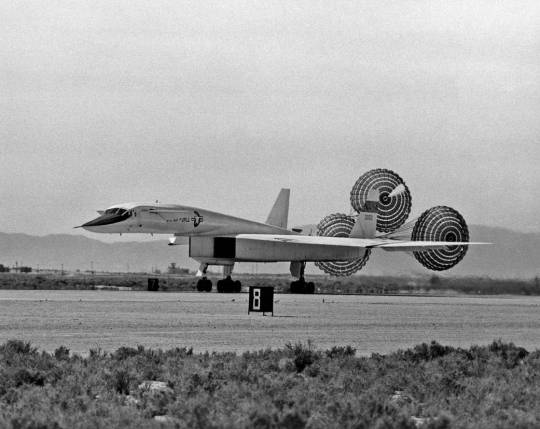
The XB-70A No. 1 is shown rolling out after landing, employing drag chutes to slow down.
The XB-70 was fitted with two small vanes for the Identically Located Acceleration and Force (ILAF) experiment. The vanes rotated 12 degrees at a rate of up to 8 cycles per second. This induced a structural vibration in the XB-70 at a known frequency and amplitude. The XB-70’s accelerometers detected the disturbances, then signaled the aircraft’s stability augmentation system to damp out the motion. When XB-70 research flights resumed on June 11, 1968, the ILAF proved its ability to reduce the effects of turbulence and atmospheric temperature changes.
Despite the accomplishments of the XB-70, time was running out for the research program. NASA had reached an agreement with the Air Force to fly research missions with a pair of YF-12As and a “YF-12C,” which was actually an SR-71. These represented a far more advanced technology than that of the XB-70. In all, the two XB-70s had logged 1 hour and 48 minutes of Mach 3 flight time. A YF-12 could log this much Mach 3 time in a single flight.
The final XB-70 research flight occurred on Feb. 4, 1969. Fulton and Sturmthal made a subsonic structural dynamics test and ferry flight. The XB-70 took off from Edwards and flew to Wright-Patterson Air Force Base, OH, where the aircraft was put on display at the Air Force Museum. The first XB-70 made 83 flights totaling 160 hours and 16 minutes, while the second XB-70 logged 46 flights in its brief life, totaling 92 hours and 22 minutes.
@kadonkey via X
16 notes
·
View notes
Note
Vietnam had all kinds of wacky guns on aircrafts.
Wacky is to put it lightly

Miniguns in WW2-era C-47 Dakota transports, now turned into the AC-47 Spooky, aka Puff the Magic Dragon.

Massive fucking 20mm turreted cannons on small and nimble OV-10 Bronco observation planes.

Another minigun next to a fucking 40mm grenade launcher in the world’s first attack helicopter, the Bell AH-1 Cobra.

20mm gunpods galore in F-4 Phantoms.

The very same .50 cal machine guns WW2-era bombers used to defend themselves from propeller driven fighters, found in the nuclear-capable strategic long range jet-powered B-52 bomber, which somehow also managed to protect it from soviet-made supersonic interceptors.
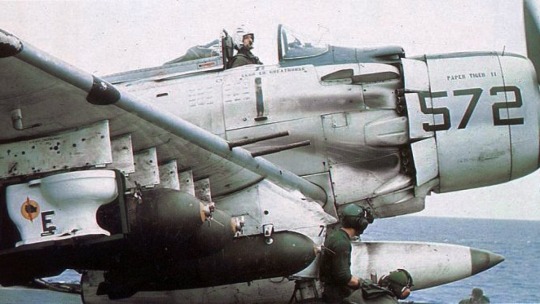
And of course, the world famous toilet bomb, used only once by an A-1 Skyraider naval attack aircraft.
51 notes
·
View notes